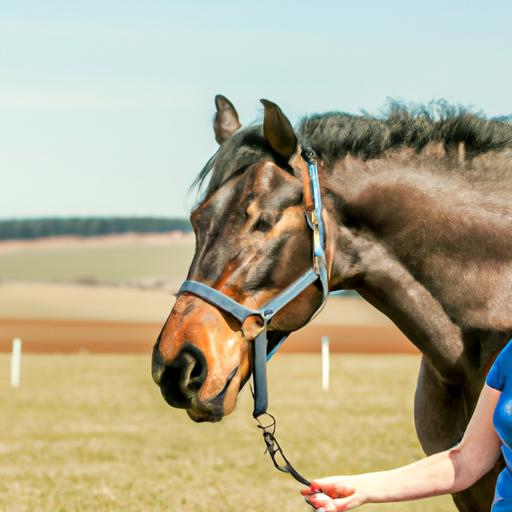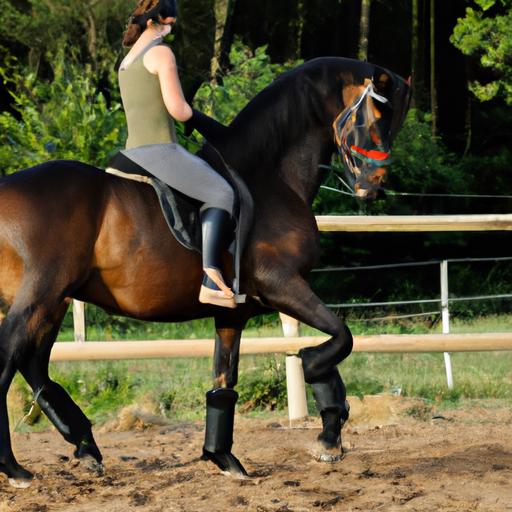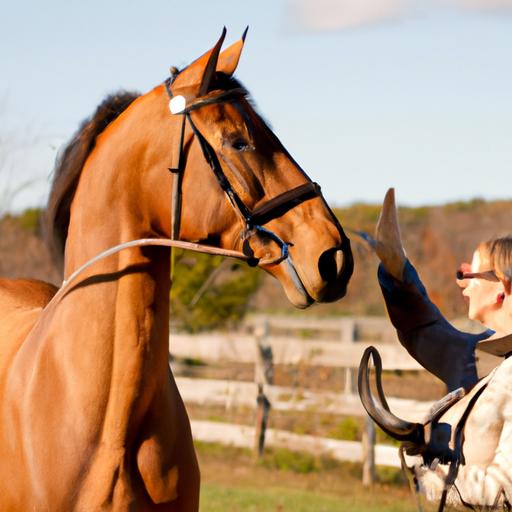Unlock effective communication and achieve mastery in horse training with our comprehensive guide on horse training commands. Enhance your bond with your equine companion and experience the benefits of clear and concise communication. Explore basic and advanced commands for a harmonious equestrian journey.
As a horse enthusiast, have you ever wondered how expert trainers effortlessly communicate with their horses, making it seem like an elegant dance between two souls? The secret lies in mastering the art of horse training commands. These commands serve as the foundation of effective communication between you and your equine companion. In this article, we will delve into the significance of horse training commands, their role in shaping behavior, and the myriad benefits they bring to your equestrian journey.
Understanding the Role of Commands in Horse Training
Imagine trying to navigate a foreign country without knowing a word of the language. It would be a bewildering experience, wouldn’t it? Similarly, when it comes to interacting with horses, commands act as the language through which we communicate our desires and expectations. These powerful cues serve as a bridge between human and equine, enabling us to convey instructions, establish boundaries, and build trust.
Importance of Horse Training Commands in Effective Communication
Clear and concise commands are the key to unlocking effective communication with your horse. They provide the necessary structure and guidance for your equine partner, ensuring that they understand what is expected of them. Whether you’re teaching basic commands like “walk” and “stop,” or advancing to more intricate maneuvers like lateral movements and lead changes, the ability to convey your intentions through commands is paramount.
Benefits of Properly Executed Horse Training Commands
When executed with finesse, horse training commands offer a multitude of benefits that extend beyond the training arena. Firstly, they enhance safety for both horse and rider, establishing a mutual understanding and reducing the risk of accidents. Furthermore, well-trained horses tend to be more responsive, willing, and attentive, making every ride a harmonious experience. Additionally, mastering commands strengthens the bond between you and your horse, fostering a deeper level of trust and companionship.
In the next section, we will explore the fundamental horse training commands that lay the groundwork for a successful training journey. Join me as we embark on this enchanting quest of developing a language that transcends words, creating a profound connection between human and horse.
Stay tuned for Section II, where we will dive into the realm of basic horse training commands and unravel the secrets to teaching them effectively. Remember, horse training commands are the stepping stones to unlocking a world of equestrian mastery.
Stay connected with Horsemasterypro.com for more insightful articles and expert advice on horse training commands.
Basic Horse Training Commands

Essential Commands for Beginners
When embarking on your horse training journey, mastering a set of essential commands forms the building blocks of communication between you and your equine partner. These fundamental commands lay the groundwork for further training, establishing a solid foundation for future endeavors. Here are a few key commands to get you started:
-
Walk: “Walk” is the command that initiates forward movement. Teach your horse to respond to this cue by applying gentle pressure with your legs, accompanied by a verbal command. Reward your horse with praise or a treat when they respond correctly.
-
Stop: The “stop” command is crucial for maintaining control and ensuring safety. Teach your horse to halt on command by applying gentle rein pressure while simultaneously using a verbal cue. Gradually decrease the pressure and reward your horse when they come to a complete stop.
-
Turn: Turning commands, such as “left” and “right,” are essential for maneuvering your horse smoothly. Use rein and leg aids to guide your horse in the desired direction, accompanied by verbal cues. Consistency and repetition will help your horse understand and respond to these commands effectively.
Step-by-Step Guide on Teaching Basic Commands
To teach your horse basic commands effectively, follow this step-by-step guide:
-
Establish trust and rapport: Develop a bond with your horse based on trust and respect. Spend time grooming, bonding, and establishing a positive connection before moving on to training.
-
Use clear and consistent cues: Ensure your cues are consistent and easy for your horse to understand. Combine verbal commands with physical aids, such as reins and leg pressure, to reinforce your instructions.
-
Break commands into smaller steps: Break down each command into smaller, manageable steps. For example, when teaching the “walk” command, start by rewarding your horse for taking a single step forward, gradually increasing the distance over time.
-
Reward and reinforce: Praise and reward your horse when they respond correctly to a command. Positive reinforcement, such as treats or verbal praise, motivates your horse to repeat the desired behavior.
Common Mistakes to Avoid during Basic Training
While training your horse with basic commands, it’s essential to be aware of common mistakes that can hinder progress. Avoid the following pitfalls:
-
Inconsistency: Inconsistency in cues and expectations can confuse your horse. Ensure that you use the same cues and maintain consistency in your training sessions.
-
Lack of patience: Rome wasn’t built in a day, and neither is a well-trained horse. Be patient and allow your horse time to understand and respond to commands at their own pace.
-
Overwhelming your horse: Avoid bombarding your horse with too many commands at once. Introduce one command at a time and give your horse sufficient time to grasp and master it before moving on to the next.
By mastering these basic commands, you lay a solid foundation for your horse’s training journey. Remember, patience, consistency, and positive reinforcement are the keys to success. In the upcoming section, we will dive into the realm of advanced horse training commands, building upon the skills you have developed thus far.
Join us in Section III, where we explore the realm of advanced horse training commands and unlock the secrets to taking your equestrian partnership to new heights.
Section III: Advanced Horse Training Commands

Progressing to Advanced Commands
Congratulations on mastering the basics of horse training commands! Now it’s time to take your skills to the next level by delving into the realm of advanced commands. As you progress on your equestrian journey, advanced commands will allow you to unlock new possibilities, enhance your horse’s performance, and explore various disciplines with finesse.
Specialized Commands for Performance and Competitive Activities
Are you ready to showcase your horse’s talent and compete in various equestrian activities? Specialized commands tailored to specific disciplines can elevate your horse’s performance and help you excel in the ring. Whether you’re a show jumper, dressage aficionado, or barrel racing enthusiast, mastering these discipline-specific commands is crucial for success. From collection and extension movements to flying lead changes and precise transitions, each discipline demands a unique set of commands that highlight your horse’s abilities.
Techniques to Master Advanced Commands
Mastering advanced commands requires patience, dedication, and a deep understanding of your horse’s individual needs. Here are some techniques to help you on your journey:
1. Progressive Training: Gradually build upon the foundation of basic commands, introducing new elements and challenges to keep your horse engaged and motivated.
2. Clear Communication: Refine your cues and ensure they are consistent and precise. Horses are incredibly attuned to subtle changes in body language and aids, so clarity in your communication is essential.
3. Reward-Based Training: Utilize positive reinforcement techniques to reinforce correct responses. Rewarding your horse with praise, treats, or a brief break after successful execution will create a positive association and encourage continued progress.
4. Consistency and Repetition: Practice advanced commands regularly to solidify your horse’s understanding and muscle memory. Consistency in your training sessions will lead to quicker progress and better retention of commands.
5. Seek Professional Guidance: Consider working with a knowledgeable trainer who specializes in your chosen discipline. Their expertise can provide valuable insights, personalized guidance, and help you refine your training techniques.
By mastering advanced commands, you unlock the potential to reach new heights in your equestrian pursuits. These specialized cues not only enhance your horse’s performance but also deepen the connection and trust between you and your equine partner.
In the upcoming section, we will explore the power of effective communication through body language and how it can complement and reinforce your horse training commands. Harness the power of non-verbal cues and watch your partnership with your horse flourish.
Remember, Horsemasterypro.com is your trusted resource for expert advice and valuable insights on mastering advanced horse training commands. Stay tuned for more!
Section IV: Effective Communication through Body Language

Significance of Body Language in Horse Training
In the realm of horse training, words alone are not enough to establish a profound connection with your equine partner. Body language plays a pivotal role in communicating your intentions and emotions to your horse. Horses are incredibly perceptive creatures, capable of picking up on even the subtlest of cues. By harnessing the power of body language, you can enhance your communication and strengthen the bond with your horse.
How to Use Body Language to Reinforce Commands
Body language acts as a silent conversation between you and your horse, serving as a reinforcement tool for your commands. When teaching a new command, ensure that your body movements align with the desired response. For example, when asking your horse to “halt,” stand tall with your weight evenly distributed and your energy focused. This visual cue will help your horse understand the command and respond accordingly. Remember, consistency in your body language is key to reinforcing the message and preventing confusion.
Tips for Developing a Strong Connection with Your Horse
Establishing a strong connection with your horse goes beyond words and commands. It requires cultivating a deep understanding and mutual trust. Here are some tips to help you develop a profound connection with your equine companion:
1. Spend Quality Time Together
Invest time in building a solid foundation of trust and companionship. Engage in activities beyond training, such as grooming, hand grazing, or simply spending quiet moments together. This quality time strengthens the bond and fosters a deeper connection.
2. Be Mindful of Your Energy
Horses are highly sensitive to the energy we emit. Approach your horse with calmness, confidence, and positivity. Be aware of your body language and ensure it conveys a sense of harmony and trustworthiness.
3. Listen and Observe
Pay attention to your horse’s body language and responses. By listening to their cues and observing their reactions, you can better understand their needs and emotions. This attentiveness allows for more effective communication and a greater sense of understanding.
4. Practice Patience and Consistency
Building a strong connection takes time and patience. Consistency in your training methods and communication is crucial. Avoid becoming frustrated or impatient, as this can hinder progress. Remember, every interaction is an opportunity to deepen your bond.
By using your body language effectively and nurturing a strong connection, you’ll become a master of communication and achieve remarkable results in your horse training journey. In the next section, we will explore the importance of consistency and reinforcement in horse training. Let’s continue our quest for equestrian excellence!
For more valuable insights and expert guidance on horse training commands, visit Horsemasterypro.com. Together, let’s unlock the true potential of your equine partnership.
Section V: Consistency and Reinforcement in Horse Training
Importance of Consistency in Command Execution
Consistency is the key to success in horse training. When it comes to executing commands, consistency breeds clarity and reinforces the desired behavior. Horses thrive on routine and predictability, and by consistently using the same cues and signals, we establish a clear language that they can understand and respond to. Consistency also helps to prevent confusion and mixed signals, ensuring that our equine partners know exactly what is expected of them.
To achieve consistency, it is crucial to maintain a consistent body position, voice tone, and timing when giving commands. By doing so, we create a reliable pattern that horses can recognize and interpret. Remember, horses are incredibly perceptive creatures, capable of picking up on subtle cues and nuances. By consistently reinforcing our commands, we build a strong foundation for effective communication.
Reinforcement Techniques to Ensure Command Retention
Consistency alone is not enough; reinforcement is equally important in the training process. Reinforcement refers to the act of rewarding desired behavior, which encourages horses to repeat the behavior in the future. Positive reinforcement, such as praise, treats, or a gentle pat, can be highly effective in solidifying the horse’s understanding and motivation to comply with commands.
Reinforcement should be immediate and consistent, reinforcing the desired behavior at the exact moment it occurs. This helps the horse associate the command with the reward, strengthening the connection between the two. It is essential to identify what motivates your horse the most, whether it’s a particular treat, verbal praise, or a scratch in their favorite spot. By using the right reinforcement techniques tailored to your horse’s preferences, you can enhance their learning experience and create positive associations with the commands.
Maintaining a Training Schedule for Consistent Practice
Consistency extends beyond individual training sessions; it also involves maintaining a consistent training schedule. Regular training sessions not only reinforce commands but also help horses develop muscle memory and retain what they have learned. By establishing a routine and dedicating specific time for training, you create a structured environment that supports consistent practice.
Plan your training sessions strategically, breaking down the training into smaller, manageable tasks. This allows you to focus on specific commands and ensure that your horse has a solid understanding before progressing to more advanced exercises. Consistency in training schedule helps both you and your horse stay motivated and engaged, leading to steady progress and a stronger bond.
In Section VI, we will address common issues that may arise during command execution and explore strategies for troubleshooting them. Remember, consistency and reinforcement are the pillars of successful horse training, paving the way for harmonious communication and remarkable achievements.
Continue your journey toward horsemanship mastery with Horsemasterypro.com, where you’ll find a wealth of knowledge and guidance to enhance your horse training experience.


